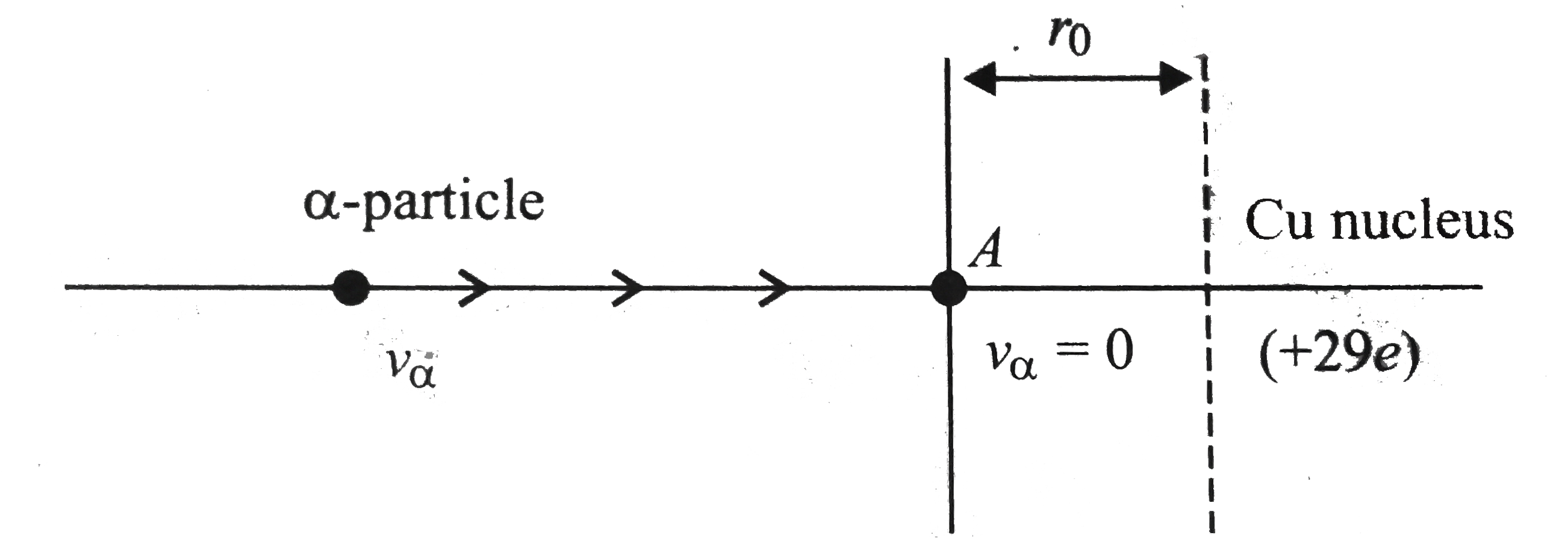With what velocity should an α- particle travel towards the nucleus of a copper atom at a distance of 10−13m from the nucleus of the copper atom?

As the alpha particle approaches the cu nucless , it decelectrates due to reqlision it and finaly its velocity becomes zero at point A (which is the turning point) After that , the α particle moves in the left derection (accelarating )
To arrive at a distance v0 from the nucless , the kinetic energy of alpha particle should be equal to the electrosstatic potential energy of it i.e.KE=EPE
12mav2a=KaaqNv0
ma = mass of α particle =4×(1.67×10−27kg)
Gv= velocity of α particle = ?
K=9×109NmC−2
q0 = Charge on α particle =2×(+1.6×10−19C)
v0 = Minilum distance of approach
qN = cahrge on Cu nucless =Ze=29(+1.6×10−19C)
d= Distance from necless =10−13m
⇒Gv=√2KqaqNmav0
Substituting the given velues we get
va=6.325×106ms−1
Topper's Solved these Questions
- ATOMIC STRUCTUREBOOK - CENGAGE CHEMISTRYCHAPTER - ATOMIC STRUCTUREEXERCISE - Exercises (Subjective)
52 Videos
- ATOMIC STRUCTUREBOOK - CENGAGE CHEMISTRYCHAPTER - ATOMIC STRUCTUREEXERCISE - Exercises Linked Comprehension
50 Videos
- APPENDIX - INORGANIC VOLUME 1BOOK - CENGAGE CHEMISTRYCHAPTER - APPENDIX - INORGANIC VOLUME 1EXERCISE - chapter-7 Single correct answer
1 Videos
- CHEMICAL BONDING AND MOLECULAR STRUCTUREBOOK - CENGAGE CHEMISTRYCHAPTER - CHEMICAL BONDING AND MOLECULAR STRUCTUREEXERCISE - Archives Subjective
15 Videos
Similar Questions
With what velocity should as α- particle travel toward the nucless of a copper atom at a distance of 1013m from the nucless of the copper atom ?
View SolutionWith what velocity should anα paricle towards the nucless of a copper atom so as to errive at a distance 10−3m from the nucless of the copper atom ?
View Solution
Knowledge Check
With what velocity should an α paricle travel towards the nucleus of a copper atom so as to arrive at a distance 10−13m from the nucleus of the copper atom?
A6.34×106m/secB63.4×106m/secC0.634×106m/secD6.34×10−6m/secIn the Rutherford's experiment, a particles were bombarded towards the copper atoms so as to arrives a distance of 10−13 metre from the nucleus of copper and then getting either deflected or traversing back. The a-particles did not move further closer
The velocity of the a-particles must beA8.32×108cm/secB6.32×108cm/secC6.32×108m/secD6.32×108km/secIn the Rutherford's experiment, a particles were bombarded towards the copper atoms so as to arrives a distance of 10−13 metre from the nucleus of copper and then getting either deflected or traversing back. The a-particles did not move further closer
The velocity of the a-particles must beANαsin(+θ2)BNdσdΩα1sin4θCNdσdΩα1sin4(θ/2)DN=sin.θ2
With what velocity should an α-particle travel towards the nucleus of a Cu atom so as to arrive at a distance 10−13 metre from the nucleus of the Cu atom? (Cu=29,e=1.6×10−19C,ε0=8.85×10−12J−1C2m−1,me=9.1×10−31kg)
View SolutionIn the Rutherford's experiment, a particles were bombarded towards the copper atoms so as to arrives a distance of 10−13 metre from the nucleus of copper and then getting either deflected or traversing back. The a-particles did not move further closer
It can also be concluded that the electrostatic potential energy is equal to
View SolutionThe particles present in the nucleus of an atom are-
View SolutionThe particles present in the nucleus of an atom are
View SolutionThe fundamental particles not present in the nucleus of hydrogen atom is
View Solution
